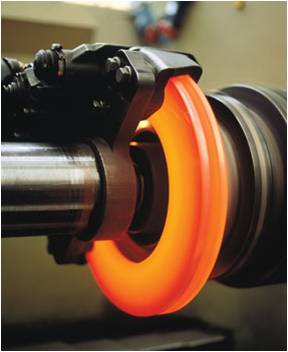Friction: Difference between revisions
m (1 revision imported: From the summer) |
m (1 revision imported) |
||
| (5 intermediate revisions by 3 users not shown) | |||
| Line 1: | Line 1: | ||
[[Category:Phets]] | [[Category:Phets]] | ||
[[Category:Done | [[Category:Done 2020-05-30]] | ||
<onlyinclude>Friction is an [[everyday force]] that | [[Category:Translated to French]] | ||
[[fr:Frottement]] | |||
[[File:Friction brake.jpeg|framed|Figure 1. The thermal energy generated during friction braking can be seen in this friction brake/rotor set-up during stress testing.<ref>This image is from http://www.ematg.org.uk/new-pics-01/hot-brake-disc-disc2 accessed August 15th, 2017.</ref>]] | |||
<onlyinclude>Friction is an [[everyday force]] that is created by two surfaces interacting.</onlyinclude> When these surfaces slide against each other, this interaction increases the [[thermal energy]] of the two surfaces (the [[temperature]] goes up). While it is easy to think of friction as a 'bad' thing, friction is needed in order to drive (it's what pushes the wheels on our car forward and allows us to stop and turn), or even walk. | |||
Friction is why: | Friction is why: | ||
* [[brake]] rotors get hot when stopping or slowing down, | * [[brake]] rotors get hot when stopping or slowing down, | ||
* rubbing pieces of wood together can start a fire (see [http://www.instructables.com/id/7-Methods-of-Primitive-Fire-Starting/ 7 methods of primitive fire starting]), | * rubbing pieces of wood together can start a fire (see [http://www.instructables.com/id/7-Methods-of-Primitive-Fire-Starting/ 7 methods of primitive fire starting]), | ||
* rubbing hands together | * rubbing hands together make them warm. | ||
Friction in [[engine]]s and [[simple machine|machine]]s contributes to | Friction in [[engine]]s and [[simple machine|machine]]s contributes to [[energy]] loss, which is what wears out the parts in a car (hence the need for [[lubricating oil]]). Friction is a [[non-conservative force]], meaning [[energy]] is transferred to new forms not useful to the system (but doesn't disappear from the universe, see [[conservation of energy]]). | ||
There are three types of friction: | There are three types of friction: | ||
# [http://hyperphysics.phy-astr.gsu.edu/hbase/frict2.html#sta Static friction], when surfaces | # [http://hyperphysics.phy-astr.gsu.edu/hbase/frict2.html#sta Static friction], when surfaces do not move with respect to each other, like shoes on a floor while walking, or tires on the road while driving. | ||
# [http://hyperphysics.phy-astr.gsu.edu/hbase/frict2.html#kin Kinetic friction], when surfaces move with respect to each other like shoes on a banana peel, or skidding tires on a road. | # [http://hyperphysics.phy-astr.gsu.edu/hbase/frict2.html#kin Kinetic friction], when surfaces move with respect to each other like shoes on a banana peel, or skidding tires on a road. | ||
# Rolling friction, which is also known as [[rolling resistance]]. | # Rolling friction, which is also known as [[rolling resistance]]. | ||
For a more complete description of physics please consult [http://hyperphysics.phy-astr.gsu.edu/hbase/fricon.html hyperphysics]. | For a more complete description of physics please consult [http://hyperphysics.phy-astr.gsu.edu/hbase/fricon.html hyperphysics]. | ||
==Phet Simulation== | ==Phet Simulation== | ||
The [http://phet.colorado.edu/ University of Colorado] has graciously allowed us to use the following Phet simulation. This simulation explores | The [http://phet.colorado.edu/ University of Colorado] has graciously allowed us to use the following Phet simulation. This simulation explores the relationship between macroscopic motion, frictional forces, microscopic [[kinetic energy]] and temperature: | ||
<html> | <html> | ||
<iframe src=" | <iframe src="https://phet.colorado.edu/sims/html/friction/latest/friction_en.html" width="800" height="600"></iframe> | ||
</html> | </html> | ||
==For Further Reading== | |||
* [[Heat]] | |||
* [[Thermal energy]] | |||
* [[Temperature]] | |||
* [[Atom]] | |||
* Or explore a [[Special:Random|random page]] | |||
[[Category:Uploaded]] | [[Category:Uploaded]] | ||
Latest revision as of 00:03, 27 September 2021

Friction is an everyday force that is created by two surfaces interacting. When these surfaces slide against each other, this interaction increases the thermal energy of the two surfaces (the temperature goes up). While it is easy to think of friction as a 'bad' thing, friction is needed in order to drive (it's what pushes the wheels on our car forward and allows us to stop and turn), or even walk.
Friction is why:
- brake rotors get hot when stopping or slowing down,
- rubbing pieces of wood together can start a fire (see 7 methods of primitive fire starting),
- rubbing hands together make them warm.
Friction in engines and machines contributes to energy loss, which is what wears out the parts in a car (hence the need for lubricating oil). Friction is a non-conservative force, meaning energy is transferred to new forms not useful to the system (but doesn't disappear from the universe, see conservation of energy).
There are three types of friction:
- Static friction, when surfaces do not move with respect to each other, like shoes on a floor while walking, or tires on the road while driving.
- Kinetic friction, when surfaces move with respect to each other like shoes on a banana peel, or skidding tires on a road.
- Rolling friction, which is also known as rolling resistance.
For a more complete description of physics please consult hyperphysics.
Phet Simulation
The University of Colorado has graciously allowed us to use the following Phet simulation. This simulation explores the relationship between macroscopic motion, frictional forces, microscopic kinetic energy and temperature:
For Further Reading
- Heat
- Thermal energy
- Temperature
- Atom
- Or explore a random page
- ↑ This image is from http://www.ematg.org.uk/new-pics-01/hot-brake-disc-disc2 accessed August 15th, 2017.

